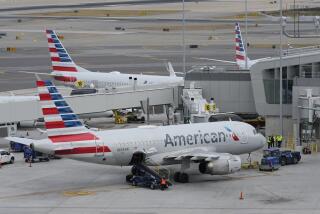Weigh and Pay or Stay
- Share via
In recognition of the changing, how shall we say, American physique, the Federal Aviation Administration has ordered airlines to add 10 pounds (1/200th of a ton!) to the assumed weight of each air passenger and five more assumed pounds to their luggage. (Are bags also getting more obese?)
This creates more realistic load estimates to ensure flight safety, especially in smaller planes where a few hundred pounds around the tail or hips can change a craft’s airworthiness. Flight safety is good, better than the alternative.
But this new regulation, taking effect in about three months, also suggests a resetting of fatty airfares. Currently airlines use an intentionally arcane “system” of fare “calculations” that appears to require banks of sophisticated computers in Oklahoma. No one understands why it can cost less to fly from Los Angeles to New York than to St. Louis, which appears closer to Los Angeles on most maps.
In reality, it can be revealed here, U.S. airline fares are set during each reservations call by agents tapping a fake computer keyboard while colleagues throw darts at a wall-size chart containing numerous potential prices above $99. It all depends on when, where and how tickets are purchased and what numbered square gets hit by what colored dart: Two average passengers can pay widely divergent rates for putting their personal fuselages in the same seat row of the same airplane en route to the same airport. (Ticket taxes, by the way, are set by average scores of arena football games.) The airlines correctly count on crowded customers, struggling for elbow supremacy on the single armrest, not to exchange ticket cost data.
So here’s a new, simpler -- more healthy -- and even democratically fair way to set airfares: Do it by weight. It works great for FedEx and UPS. If you’re smaller, you pay less. If you’re larger, you pay the plus-size fare. The more it costs to move a corpulent American, the more that person pays. Everybody pays, say, $100 for the first 100 pounds. After that, you fork over a dime per pound for every 100 miles. Thus, for a 500-mile trip a 190-pounder (the new FAA summer average) would pay $145 -- $100 plus 90 pounds times 10 cents times 5. Each way.
This could affect ship cruises and New Orleans eateries since travelers would be re-weighed for the return flight. Those porking up on vacation would pay a supplemental weight charge to get home.
Such fares could finally encourage millions of obese Americans to diet, especially on travel days, and to stop carrying bottles of water and steamer trunks onboard.
To improve revenues, airlines could fight back, positioning buttered-popcorn machines near ticket counters and offering free chocolate and Krispy Kremes. It’s the American weigh.
More to Read
Sign up for The Wild
We’ll help you find the best places to hike, bike and run, as well as the perfect silent spots for meditation and yoga.
You may occasionally receive promotional content from the Los Angeles Times.






